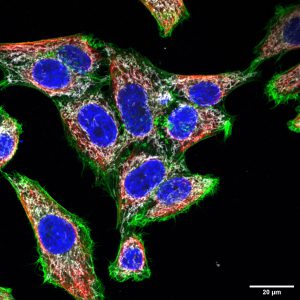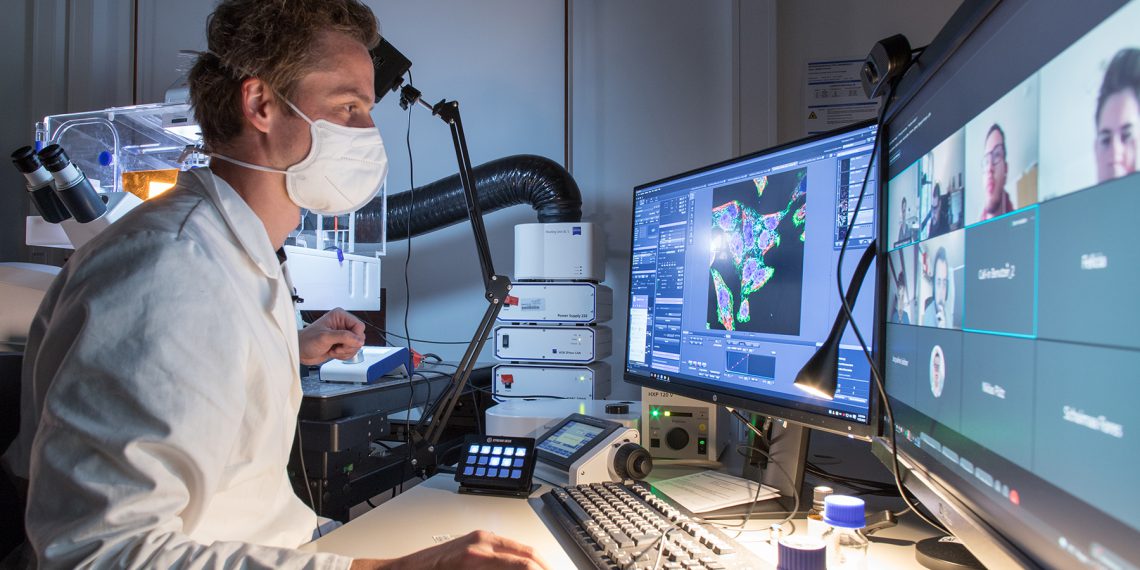During the Corona pandemic, hands-on laboratory work was very limited. At the Center for Advanced Imaging (CAi) at Heinrich Heine University Düsseldorf (HHU), remote interfaces are successfully used to help students learn how to operate modern microscopes and analyze the images obtained.
The team at CAi teaches students how to work with modern microscopes, especially confocal laser scanning microscopes. The students need this knowledge to be able to examine samples from biology, medicine, chemistry or physics independently later on. They also have to learn how to prepare the samples, evaluate the microscope images obtained and manage the large volumes of data — often dozens to hundreds of gigabytes per image.
But how does all this work in Corona times, when spacing requirements and limits on the number of people mean that a dozen students are no longer allowed to experiment in the lab? Since the summer semester of 2020, the CAi team has been using a remote interface for teaching purposes, with the help of which students can remotely control the highly complex equipment from home.
A supervisor then sits in front of the microscope in the lab, and the students are connected to the microscope’s operating computer using special software. In the video conference that runs simultaneously, the supervisor explains the device and operating software, how a sample must be prepared, and how good images can eventually be taken from it and analyzed.
“It’s amazing that the students can do remotely over 90 percent of what is possible with the microscope. Of course, I have to prepare the sample on site and roughly search and adjust the image; the big screws on the microscope don’t work remotely yet.”
- Dr. Sebastian Hänsch, staff member and internship supervisor at CAi
Likewise, the students can and should consult and exchange ideas with each other during their work so that they can work out their own solutions. This is possible through video conferencing, during which the students simultaneously see the virtual control panel of the microscope. Although only one can actively operate the controls at a time, fellow students can provide important guidance by directing their mouse pointer to the right place on the screen.
Digital technology also has its limitations when it comes to teaching students how to use a microscope. The haptic element is missing. Says Hänsch, “To give students an idea of this, we gave them very simple ‘folding scopes’ made of cardboard and plastic to take home, where they could assemble them and do simple experiments.” They were also given preparation fluids and glass slides so they could practice the steps to make a sample microscope-ready.

Some of the elements developed for the course will be retained when classes are available again in presence soon. Dr. Hänsch explains: “The online interface makes it much easier for all participants in larger groups to observe each work step on the instrument equally well. If, on the other hand, a dozen students are sitting in front of a single device in the lab, those in the back row can hardly see what’s happening in front.” Dr. Stefanie Weidtkamp-Peters, managing director of CAi, and Prof. Dr. Yvonne Stahl received the HHU teaching award in 2020 for the master module. They could now use parts of the prize money to technically implement this new innovative online teaching concept.
Dr. Stefanie Weidtkamp-Peters adds: “We also use the technology used for teaching in our research work at CAi. Through this, our microscopy experts can support other users on the instruments from their desks on how to take the best images.”

















